Turn Unhelpful like you Turn Undead
I recently ran Jason Thompson’s not-OSR-but-still Dreamland, which has social mechanics that lets players sway entire communities, even to the of becoming their king or queen. I think it’s a fun way to give dreamer PCs a lot of influence on the Dreamlands and their inhabitants.
But even in a more grounded, waking world adventure game, adventurers can be near-mythical heroes with great individual power but rarely any fixed address. You could see them having this sort of social magnetism. There are countless ways to do this with rulings but as a little challenge to myself, I will attempt to use the mechanic the B/X gods gave us for crowd control: the holy turn undead tablet. I’ll call this procedure turning the unhelpful (at least until I have a less ridiculous idea). 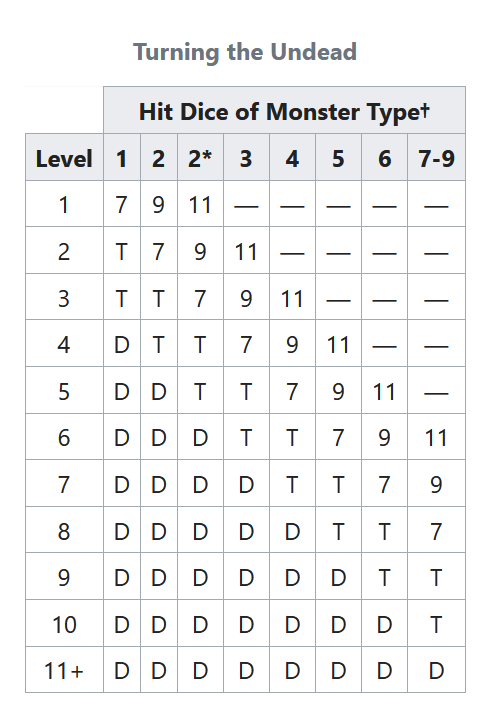
Variable prerequisites
How easy it is for adventurers to lead groups of commoners into potentially danger is up to your playstyle and your campaign world. You might only allow certain character classes or origins to attempt this — maybe only clerics can, or noble born characters, or redheads. You can also require that the party accomplishes a dangerous feat (ridding the region of a rampaging hydra) or that they are proclaimed Heroes of the Realm or Avatars of the Holy Faith. Learning that such a title or feat would let them enlist free flunkies or adopt adoring adepts would be a motivation for most, if not all player groups. Similarly, a single rousing speech in the town square might not be enough. Perhaps a feast would work, or specific gifts, or several days of alcove conversations. Don’t let this mechanic stop you from doing planning and roleplaying.
One cause, no more
In any case, the turn unhelpful attempt should have a single goal, even if that’s as broad as Stop worshipping toad demons or Set up a border patrol. It’s not a cheap substitute for hiring or attracting retainers.
Reading the table
Character Level: The party’s average level, taking any followers into account¹ Undead Hit Dice: Either the level of the community leader, or its social class: Example social hierarchy 1: Slave or serf 2: Commoner or day worker 2: Farmer 3: Burgher 4: Landed gentry or monastery head 5: Merchant or priest 6: Nobility or high clergy 7: Ruler or church leader² ¹ You can wield vorpal swords and cast chain lightning from the tip of your fingers, you’ll look less heroic when taking twenty crossbowmen into the dungeon.* ² A high-level campaign could use an extended table with 8 HD being monarchs or prelates, 9 HD being empresses and popes, up to demigods and the like.
Roll results
The players roll 2d6. A -1 or +1 modifier can reflect circumstances, payment, initial relationships, etc. but don’t add Charisma modifiers. The attempt targets 2d6 hit dice worth of NPCs who will follow, work, or fight, while most of the community agrees on the cause. In populated areas, the referee may count 0-level crowd members as 1/2 HD.
Failure: Uncooperative and possibly aggressive crowd¹
Near success (optional): A miss by 1 could mean payment or proof is required first
Success: Short term/low stakes. The NPCs will help for a couple of days, at no charge and as long as they’re not risking life or limb
T (Turned on): Long term/high stakes. The crowd will help for up to a few weeks, no matter the danger
D (Destroyed ego): Conversion. The targets are willing to do anything for any length of time. If they follow the party, they may require lodging and feeding ¹ The referee decides depending on the dice, or asks for a reaction roll
Okay, but what about reaction rolls?
I realise that widening the use of the turn undead table could narrow the application of the great reaction tables, which are commonly used as a social mechanic in B/X based games.
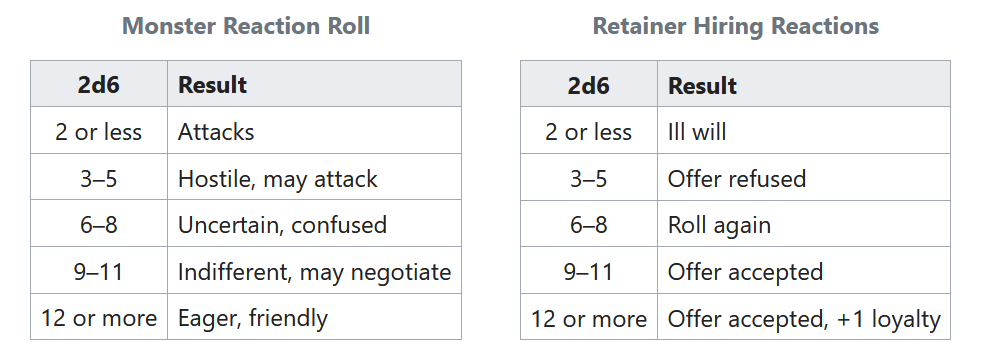 I will argue that not only are the applications different: convert/bully people into doing one thing, possibly independently from the party vs recruit a follower or convince an individual. I think you could also use the reaction table at the same time as the turn unhelpful procedure, to decide which approach should be taken. For example, a group of hostile lumberjacks would have to be bullied into leaving the druidic woods, while a well articulated speech and a keg of beer would suffice if they were merely indifferent to the party.
I will argue that not only are the applications different: convert/bully people into doing one thing, possibly independently from the party vs recruit a follower or convince an individual. I think you could also use the reaction table at the same time as the turn unhelpful procedure, to decide which approach should be taken. For example, a group of hostile lumberjacks would have to be bullied into leaving the druidic woods, while a well articulated speech and a keg of beer would suffice if they were merely indifferent to the party.
A map/layout sketch for Mörk Org
You won’t see this in the book. I made this while writing directly into Obsidian (using the Excalidraw plugin). I think it looks decent for a sketch. (You’ll want to open the png in its own tab to get better definition.)
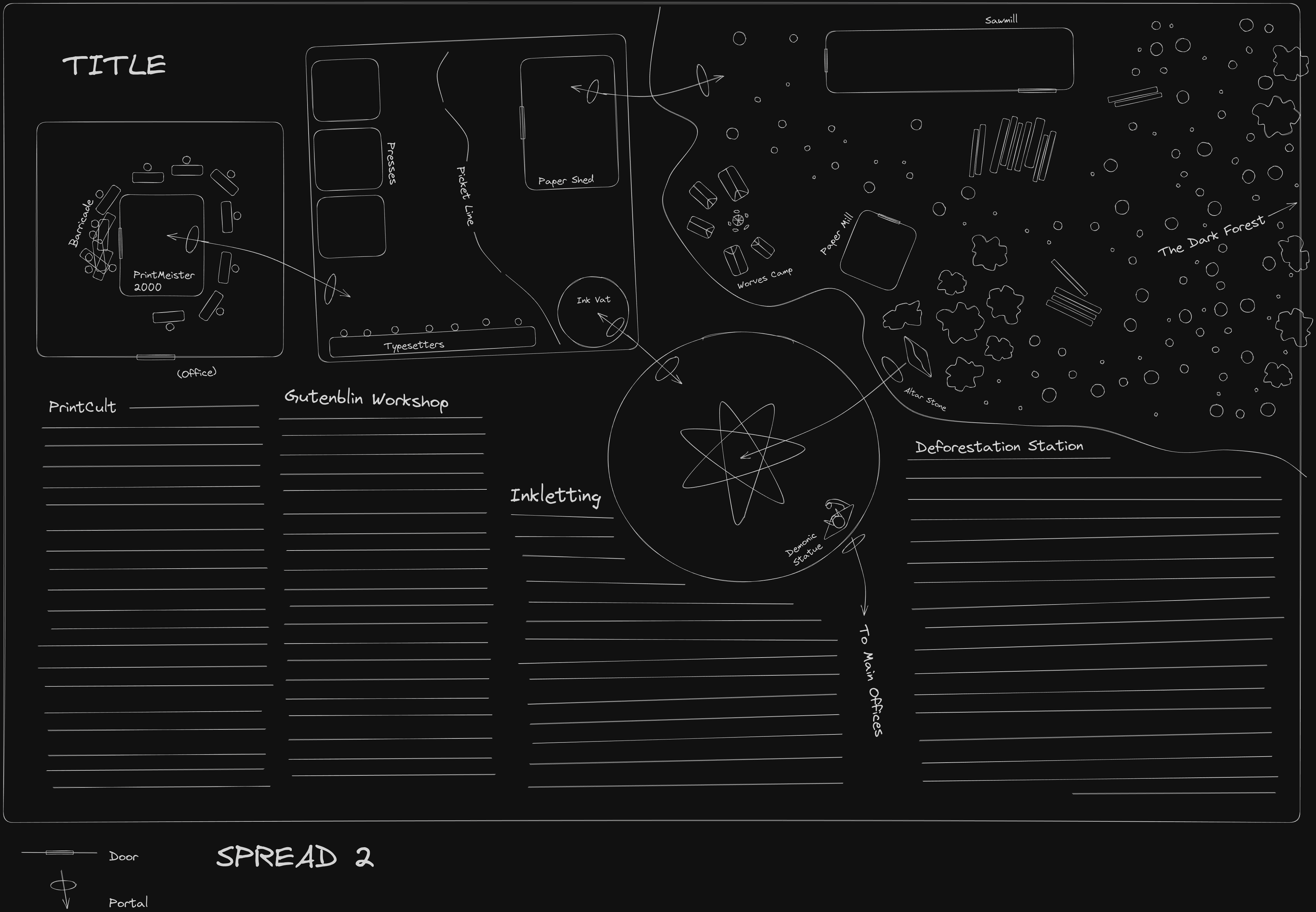 MO map and spread
MO map and spread
Between this short (2k words) adventure commission and the Dragon Meat module I finished in December, it looks like I am Writing Again. Which feels pretty good, I must say.
PlayLog: Lo! Thy Dread Empire
Lo! Thy Dread Empire might be the game that gets me to paint minis again. Aside from its fascinating grimdark yet somehow hopeful setting, it manages to mix cooperative storytelling and competitive skirmish
A book that packs a lot of extra spicy
Form factor: A5 hardcover, 90 pages, full colour on thick glossy paper. The font is large, the text is terse, and the art is everywhere — I’ve counted 36 full-page illos. It’s not one of the ultra luxury RPG books we’ve been seeing by some other Scotland based indie publishers, but it’s an eye-catching, nice to handle, sturdy game manual cum art book. Julia Nevalainen’s art is one of a kind, managing to represent each faction in the game while evoking a unique mood. There are a bunch of punk and oldhammer references, and I don’t gell them all, but it’s an engaging read nonetheless.
The gist: Capitalism has drained all life from the world and kept going, working dead people to the bone. But some undead are rising against their exploiters, and now a skeleton war is raging in the forever apocalypse. The setting is explained in half a page, the rest you’ll glean as you read the ten factions — weird, whacky, wonderful factions. I refuse to spoil your pleasure by even hinting at anything.
 It’s going down
It’s going down
Phrases and power
In her afterword, Tanya Floaker explains she aimed to create a skirmish game like a story game. It has no numbers and no dice rolls. It’s a coop-narrative game, and it lets you honestly try to kill your opponent’s little guys. Let me summarise the system: The troop descriptions are lists of tags, traits related to one of four attributes: Force, Confidence, Training, and Equipment. Further tags can represent exploits (weaknesses) or injuries gained in battle.
Conflict is resolved by finding out which side is most forceful, most confident, better trained, better equipped, who’s on advantageous terrain, etc., You look at the situation, look at your tags, and discuss which ones apply. Sides get one Violence point for each of the above. After adding a secret bid, Violence totals are compared. The winner chooses tags to be removed from the loser’s models (following common narrative sense). Losing all Force tags takes a mini out, while losing all Confidence tags forces it to run away or hide.
One thing I’ll say about tags/traits/keywords systems: they require some work. Either at the beginning when they are defined together, or when you need to know if they apply to the situation. The game doesn’t hold your hand with this, and some tags felt vague or obscure, which pushed us to be creative. I see this as a plus, but you could find it annoying. In which case, I’d recommend going over everyone’s army list before playing to define, perhaps even replace the tags that aren’t clear to everyone.
But wait, what about that secret bid? What resource do you use and where does it come from? Well, as the world was dying and reality was collapsing, money lost all value, land became barren, and the social order was all but forgotten. The only valuable that was left was raw, pure Power. The game gives you Power points (or tokens) as your only ressource. You spend them to build your warband like you do in most skirmish games, but you’ll need it to influence the battle (by bidding to win conflicts and remove tags from the opponent’s models) and to create and update your battle orders.
Chaos and orders
This is where we get back to the narrative aspect. You have to roleplay your minis because they follow their leader’s orders, and only act on the information they know. This good old wargaming mechanic pulls you from your omniscient player’s point of view and gets you back into RP mode. In the game I played against/with my friend Flo last weekend, we agreed that my overconfident Prime Sinister hadn’t seen the Swarm of Wildcats skulking in the ash-covered trees right above two enemy grunts when he led the charge. That was the end of him, but I didn’t feel bad about his death by a thousand tiny claws.
I must add that battle plans and further orders are written secretly and revealed together, as are individual actions. This is how Lo! pulls the rabbit of competitiveness out of the hat or storygaming. That, and a strong preamble about being friendliness and care. Miniatures games have a lot of baggage and you are told in no uncertain terms to dump it at the door.
Finally, there is a page about game modes. Like some of its peers (I think of Emmy Allen’s The Dolorous Stroke in particular) Lo! can be played with a referee, in a multiplayer campaign, as a regular RPG, or as a full-scale battlesystem. And with the rules under a Creative Commons Zero license, I expect (hope!) to see add-ons and hacks. Tanya and Julia are already working on a campaign supplement. My time and energy levels are pretty low right now so I won’t promise anything but… when I need a mass combat system for a roleplaying campaign, I’ll post whatever I come up with.
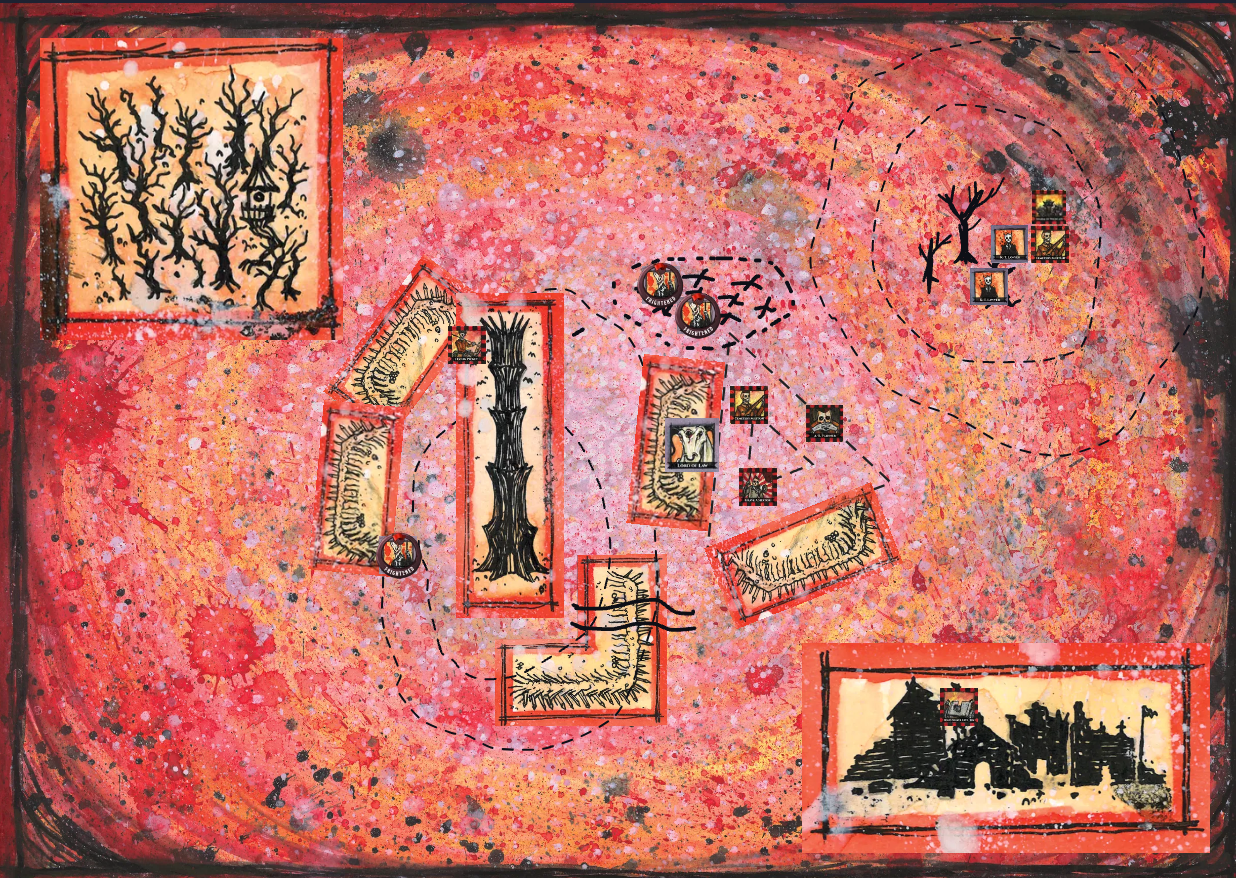 Our battlefield
Our battlefield
Literally a million free copies
Listen, I’m not an expert in minis or wargames. I spent most of my WH and 40K hobby time painting armies rather than actually playing, and that was over three decades ago. I can’t say I have played any of the recent miniature agnostic rules. I’ve painted exactly seven models in this century, and two of them are Gaslands cars. I have found something special with Lo! Thy Dread Empire, but you don’t have to take my word for it.
At the time of this writing, there are 998,935 community copies on the game’s Itch page. I don’t think the authoresses will mind if you download it for free. And I bet they’ll be grateful if you like it enough to go back and buy it.
ReadLog: The Bookmarked
I picked up this booklet after hearing the game’s pitch it at Tabletop Scotland last month. Tell me it isn’t intriguing: you play a post-apocalyptic spellcaster who frees ancient robots of the obsolete programming they have been stuck in for centuries. Your spellbook is a real-life book taken from your bookshelf, in which your store your spells as bookmarks.
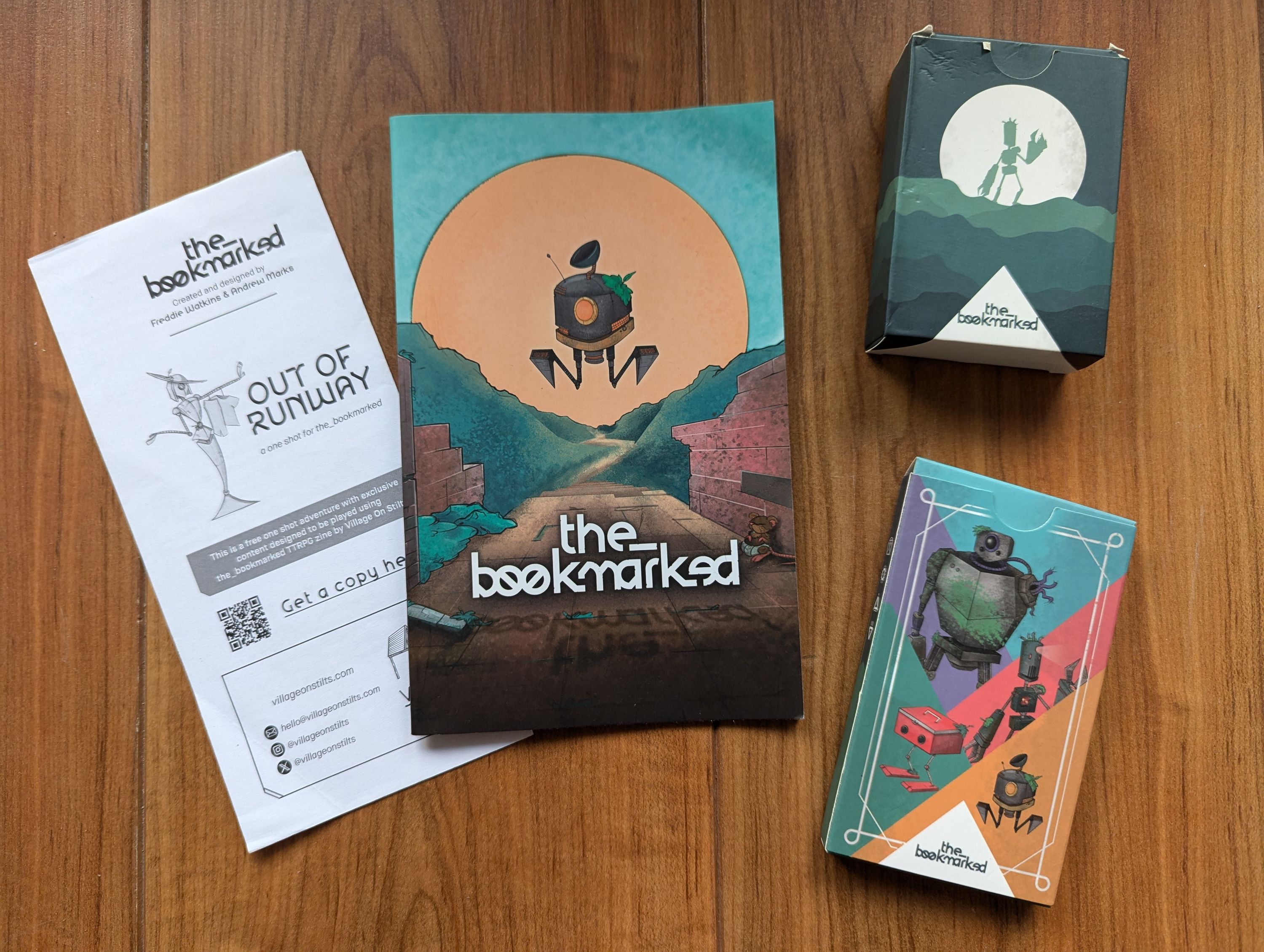 everything I got, minus the stickers
everything I got, minus the stickers
It’s a 36-page zine with 12 pages of spell bookmarks and scenario tables. It has a clear layout, very legible type despite the off-white textured background, and the art by Amber Oppel helps communicate the whimsical cuteness of the world. The design is by Freddie Watkins and Andrew Marks, with help from Liam Summers and Kyle Puller.
Tellers and Cyphers
The zine starts with a short introduction about the setting before diving into world and character creation. The former is done freely in conversation, with one simple rule: contrast the fallen human world with the onset of nature in every sentence. The latter requires players come up with a motivation and origin for their characters (the tellers), drawing inspiration from the book they brought to the game (known in the world as their cypher. There are no guidelines for choosing the books: it can be War and Peace, it can be Rolemaster’s Spell Law, the King James bible, or a Nigella cookbook. I can only imagine the diversity of characters one can have. Note that this isn’t a multiversal RPG: the characters aren’t borrowed from the book Jasper Fforde style. They’re native to the post-apocalyptic era, but they have grown with the book they’ve found in the ruins and have evolved with it.
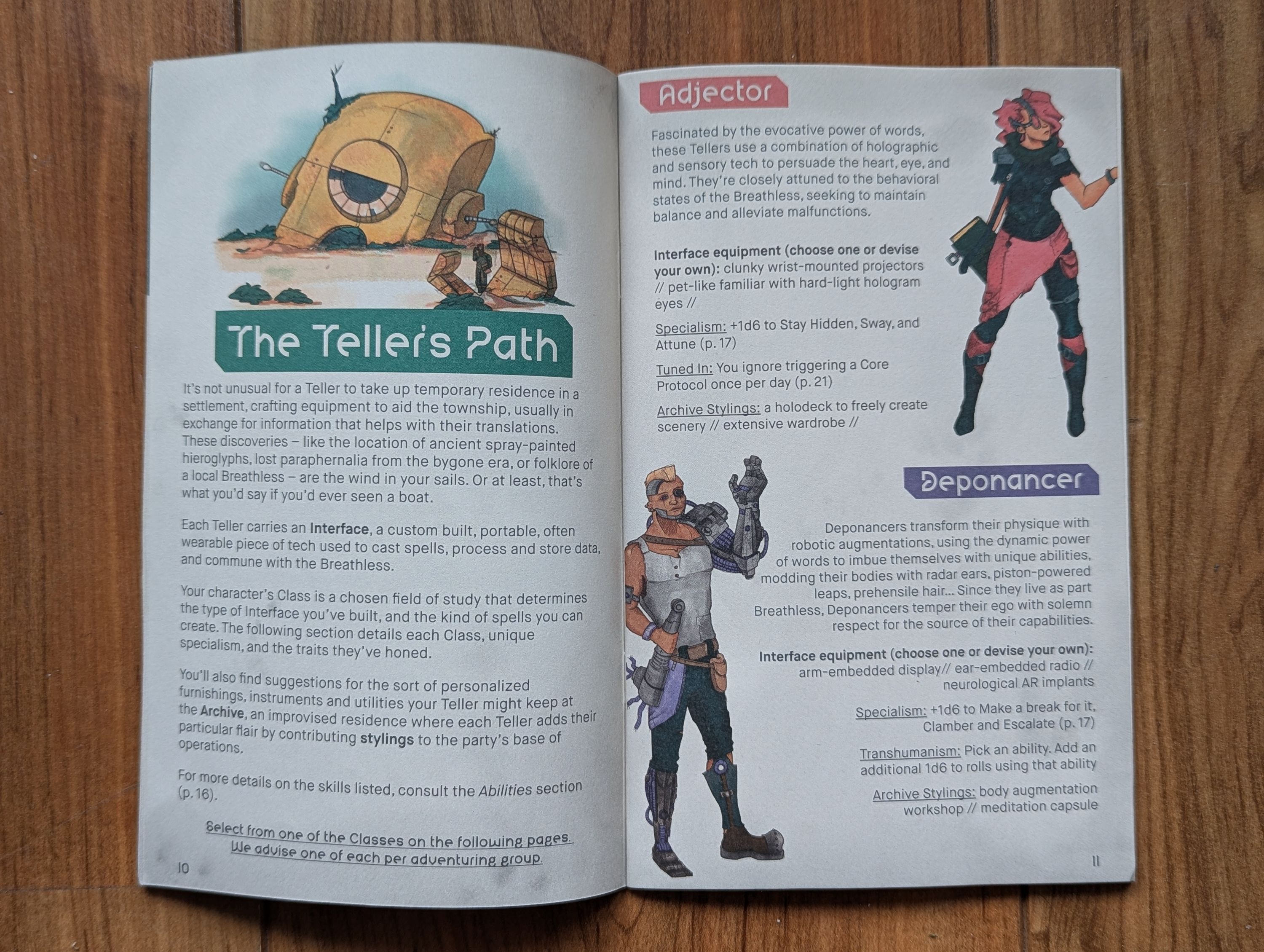 two classes per page
two classes per page
Interestingly for such a small game, The Bookmarked has classes: adjector, deponancer, divinour, punctualist, and breathful (a freed robot, which the authors recommend you don’t play initially). This isn’t 5E though: each class and its illustration take up half a page — they get a bonus to one type of action and a special ability, along with some flavour choices. No attributes, no skills, no numbers. The character sheet is the book and the spell bookmarks inside it (each class starts with a double-sided bookmark containing two spells).
Non-violent mechanics
The resolution system is d6 based: roll four dice, plus any bonus dice from your class, and each 4+ is a success. The main things you do are strictly defined : three physical actions, two social actions, and three interface actions. Interestingly, you can hide and run away but not fight, you can influence and threaten but not damage psychologically. I mean, I can’t stop you from trying to do this things, but no class gives bonuses to your rolls (and there aren’t any NPC stats or hit points or wounds system, this game really doesn’t want you to get violent). Player characters can die however: there is a multi-roll save mechanic called peril that is invoked when they fail an action with potentially dangerous consequences.
Psycuitry and the Breathless
Each scenario is centred around a breathless, an ancient robot that is carrying on its centuries old programming, negatively affecting the world and a community living nearby. Confronting the breathless to get it to break free of its programming and finally become sentient (and a breathful, then) is the final scene of each adventure and a mini-game in itself.
Depending on its current states (operational or damaged and friendly or defensive), a robot does different things, and different actions can be attempted against it. To win, the players must help the breathless achieve selfhood by pushing it to do three actions from a list divided into self-determination, self-awareness, and autonomy. They do so by rewriting its programming (an action called psycuitry), using their book’s words to change the three sentences that compose said programming (and that they’ve hopefully discovered in the adventure leading to the confrontation). The words must appear on the pages marked by one of the player’s spell.
If they fail to do this before the robot gets both damaged and defensive, it locks down or leaves and the characters have to wait, and deal with the fallout of an unchecked robot doing crazy things and worsening the local’s lives. Maybe they didn’t investigate enough before confronting the breathless, and they didn’t know enough about its original programming to tweak it efficiently.
Having not played yet, it looks like a good balance of mechanics and fictional positioning. You track the robot’s states and the programming sentences you’ve deducted, but the situation dictates what you can do just as much.
Scenario building
The zine ends with tightly packed tables to build your adventures: 11 scenarios and 45 obstacles. The GM uses these tables as a base for their locations, settlements, communities, NPCs, etc. Some entries have symbols to indicate they work well together in a series of scenarios.
These tables are detailed and atmospheric. They do the heavy lifting in communicating the game’s mood. There are stylist robots pillaging vital resources to create ever more beautiful outfits, weather balloon robots, sports team mascot robots. More Saturday morning cartoon than Terminator.
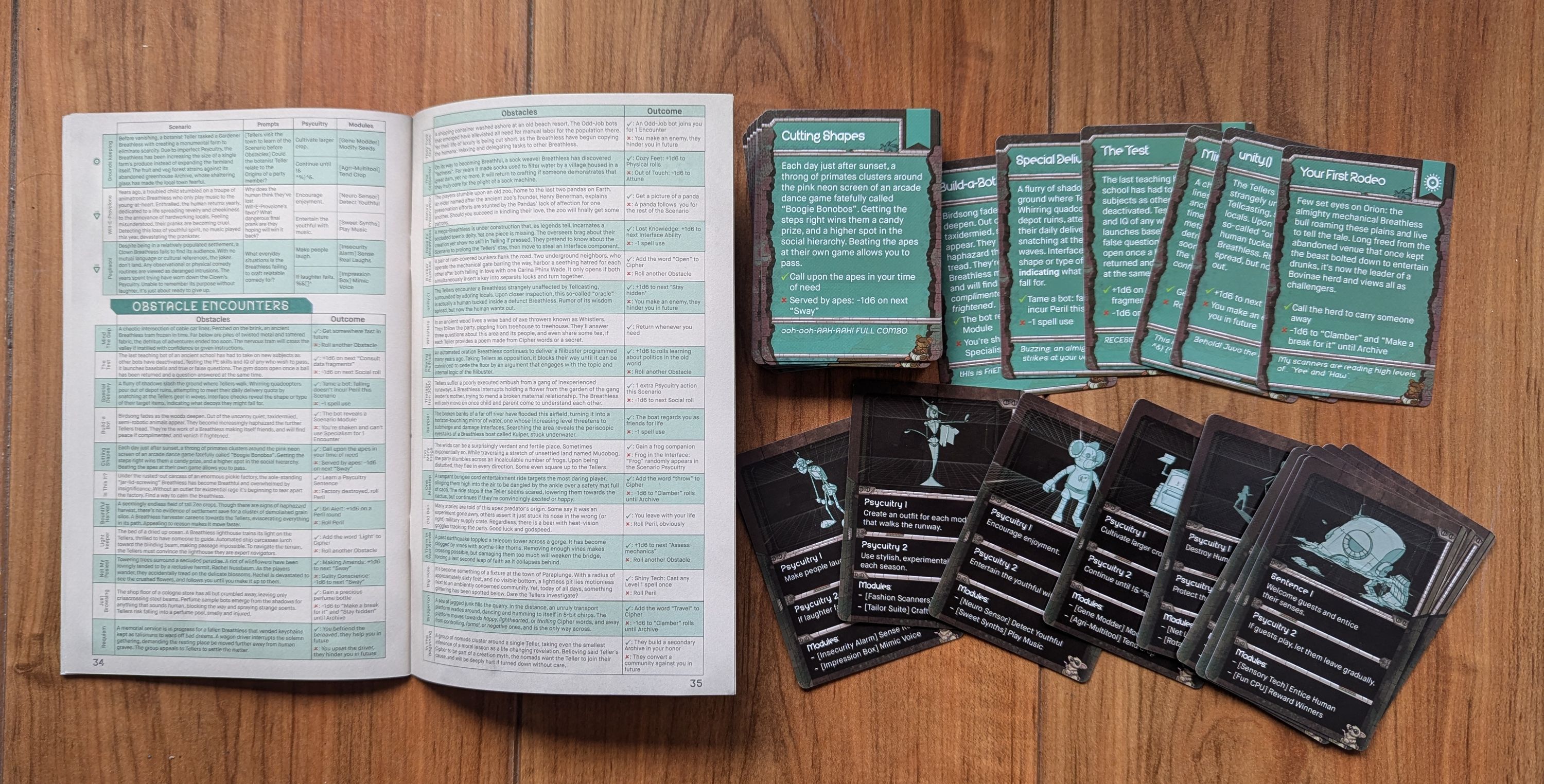 the tables and their corresponding cards
the tables and their corresponding cards
Village on Stilts has published the tables as a deck of cards (which I bought, of course), and there is a tarot-size deck containing each class’ bookmark spells. These are in the book, laid out so you can cut them out but of course I bought that too. Along with a few cute robot stickers, I was given a pamphlet with a scenario, which helped me understand how much context is needed to the tables entries/cards (which is not very much).
tl;dr
A non-violent post-apocalyptic game with a lot of flavour (and perhaps too many neologisms but that’s just me). Simple and innovative mechanics. Starts at £7 in PDF on Village on Stilt’s website. I’ll definitely keep it at hand in case there’s an opportunity to play it in person!
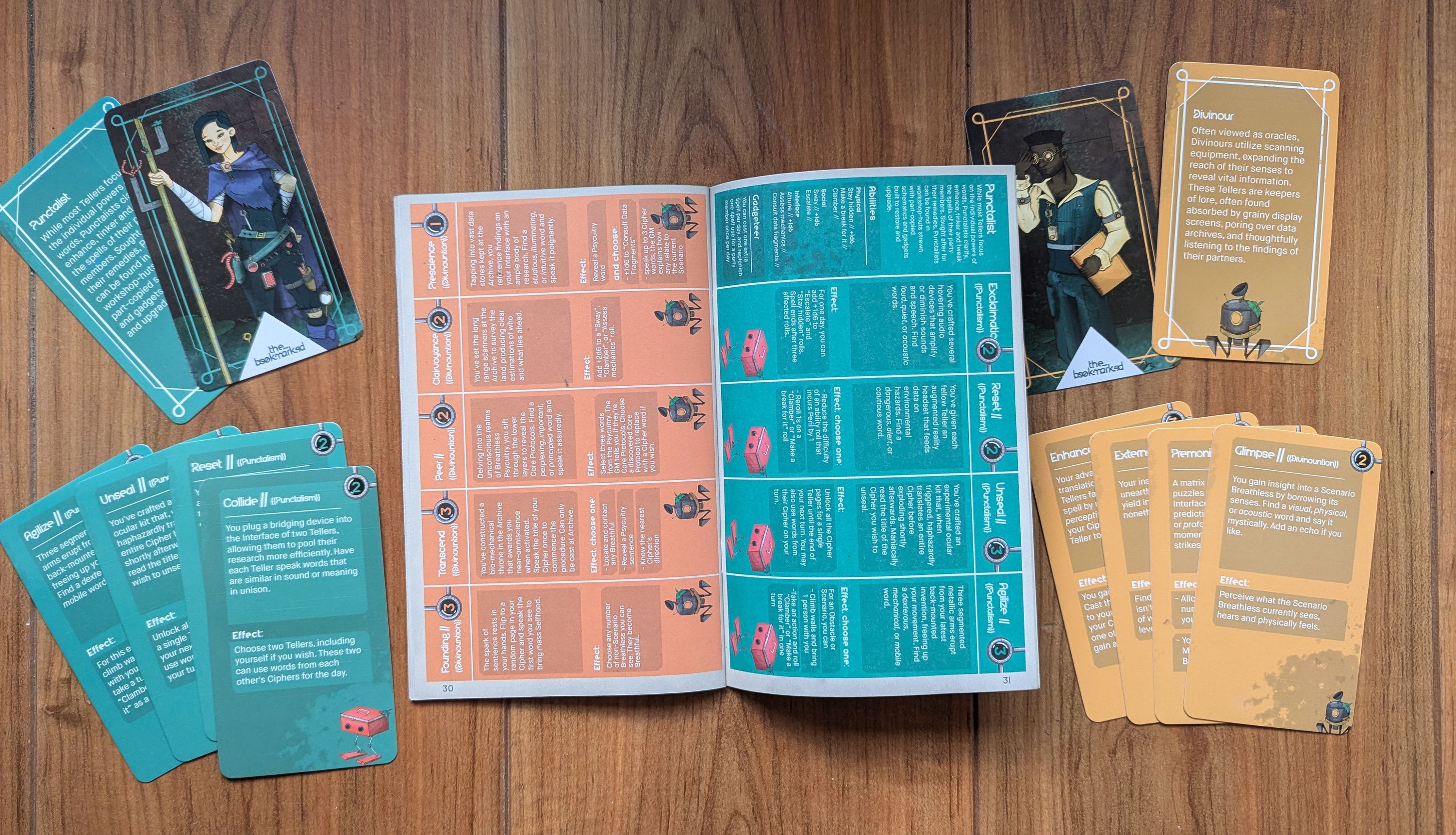 the bookmarks are nicer as tarot cards, as you would have guessed
the bookmarks are nicer as tarot cards, as you would have guessed
ReadLog: Arkeos Adventures Early Access
Here’s a French game for a change. Arkeos was a pulp adventure game and campaign released over twenty years ago. I never played and never read all of it (despite having it on my shelves all this time) but this new edition is making me want to go back to these cinematic 1930s, leading a bunch of two-fisted archeologists in a race across the world against Nazi sorcerers.
With his new publishing imprint, the original publisher Christian Grussi brings pulp action back to us, with an entirely new, diceless system. This early access (read: quickstart adventure) is a 66-page booklet, available as a pay what you want PDF from Rafiot Fringuant, or physically for €15 — which is deductible from your pledge should you chose to back the boxset.
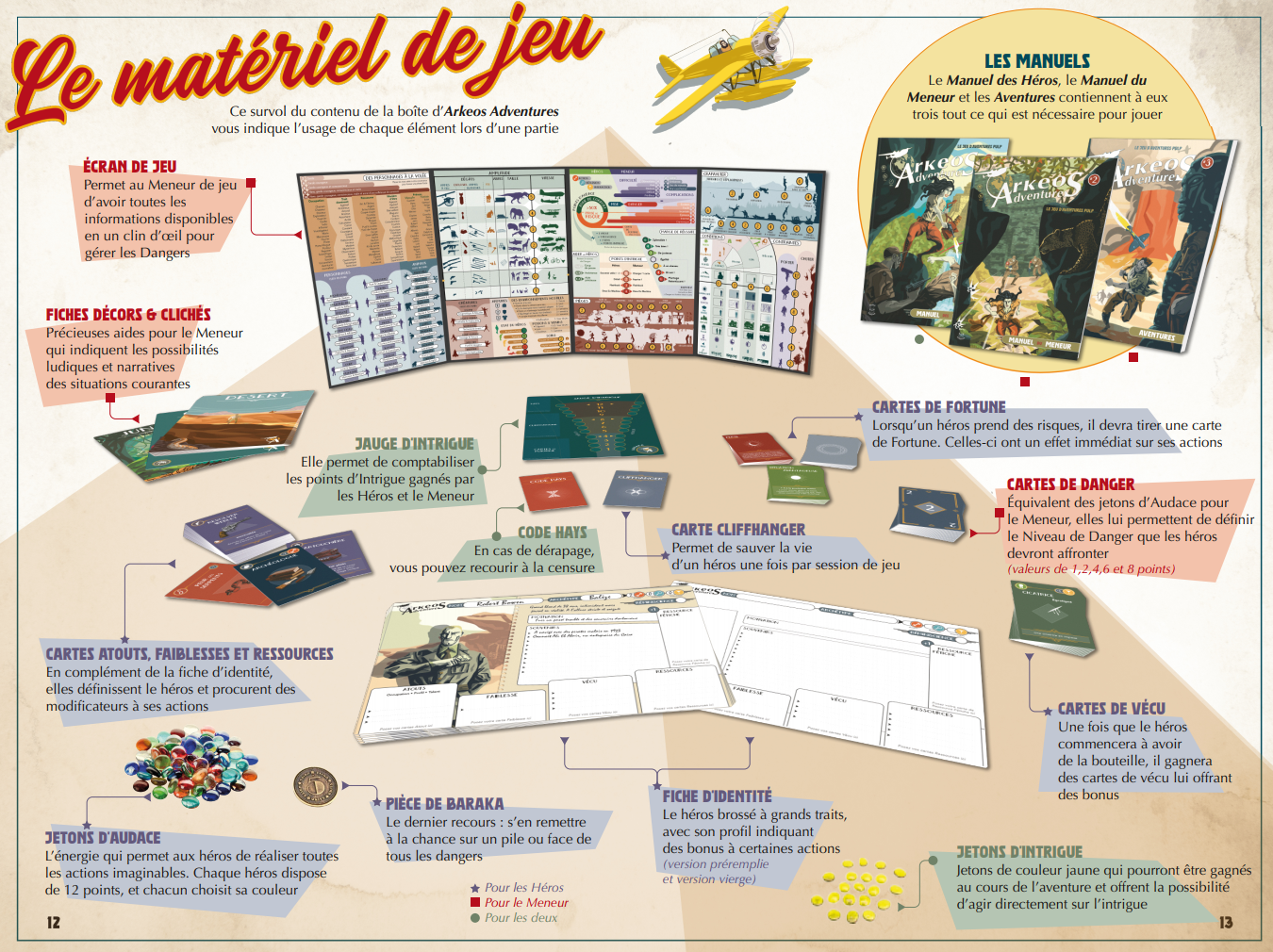 arkeos box
arkeos box
It looks like a board game…
Christian was nice enough to send me the booklet and I am very impressed with the game mechanics. Browsing the PDF after the game’s announcement, my initial impression was along the lines of “Does this need to be so complicated?” but as I read on, I realised it was due to the two infograph style spreads.
These serve to both recap the rules and give examples, and in all their colour coded glory, they gave me the wrong impression. Admittedly, the photos of the contents must have been a factor in my initial thinking.
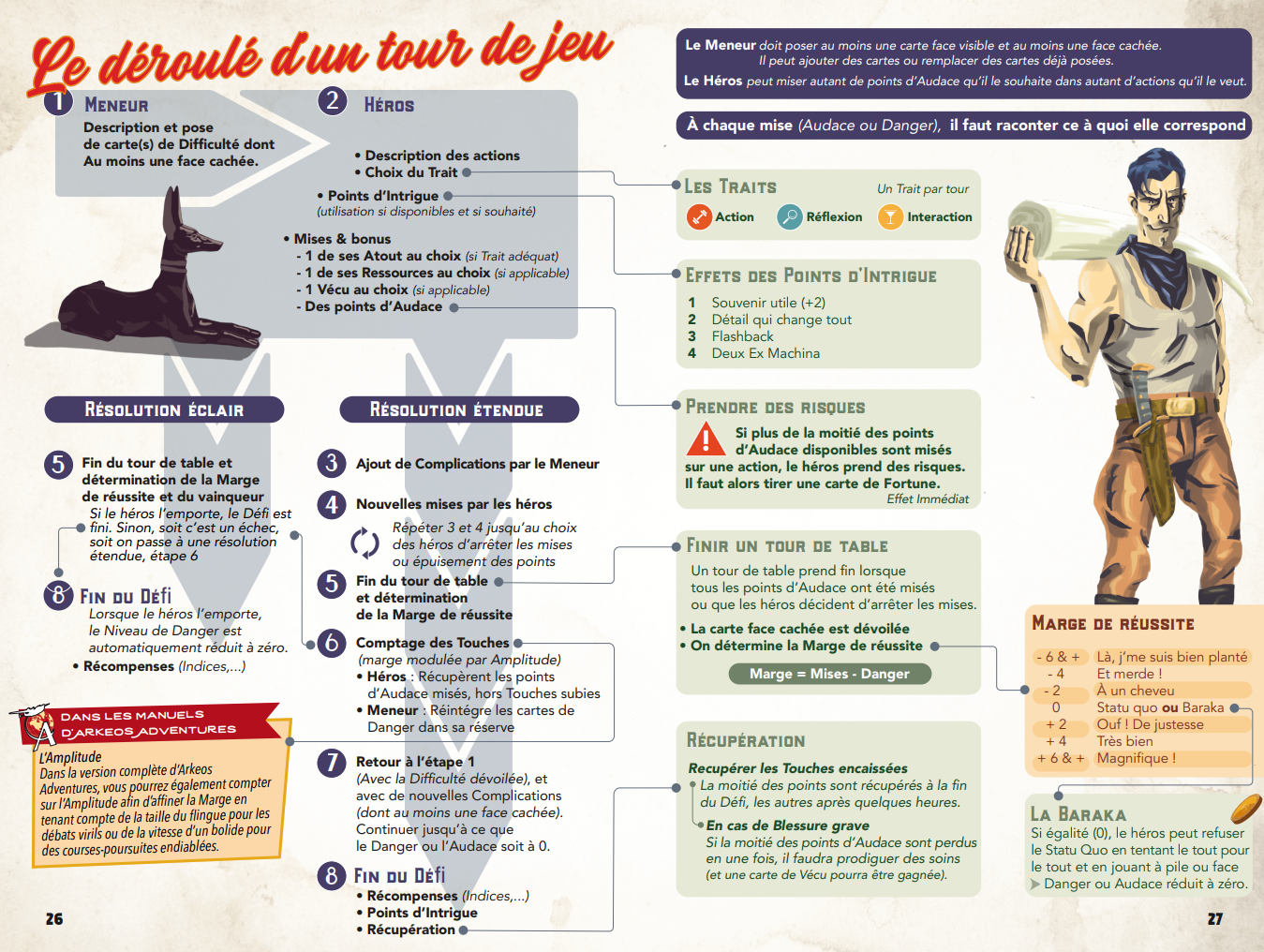 arkeos infographic
arkeos infographic
It’s smells like a board game…
As it turns out, the rules of Arkeos Adventures are straightforward enough. I bet I can explain them to you in a couple of paragraphs!
At the start of a Challenge (any situation that cannot be resolved by conversation), each character bets from their pool of Daring tokens against a general Difficulty (how sneaky that Nazi spy is) and optional Complications (the morning crowd in the souk) described by the GM and each materialised by a card bearing a number, at least one of which face down. If a Complication is only affecting a character, it is put in front of that player.
Players decide where their tokens go, describing what they’re attempting to do, and the turn is resolved by comparing each card (revealing it if needed) to the sum of the tokens bet against it. The highest number wins and the difference is subtracted either to one of the cards (player wins) or to the character’s Daring tokens (player loses). The next turn starts with the GM describing the new situation, possibly adding more Complications for one character or for everyone. And so on until the players lose all their Daring tokens or the scene’s Difficulty card is reduced to zero.
Also, a Challenge can be a simple affair where the players either succeed or fail in one turn. The grumpy doorman who refuses to let the heroes in the Explorers’ Club doesn’t come with a Difficulty and Complications! He actually comes with a single number, as does every challenge in the game. Talk about an efficient stat-block!
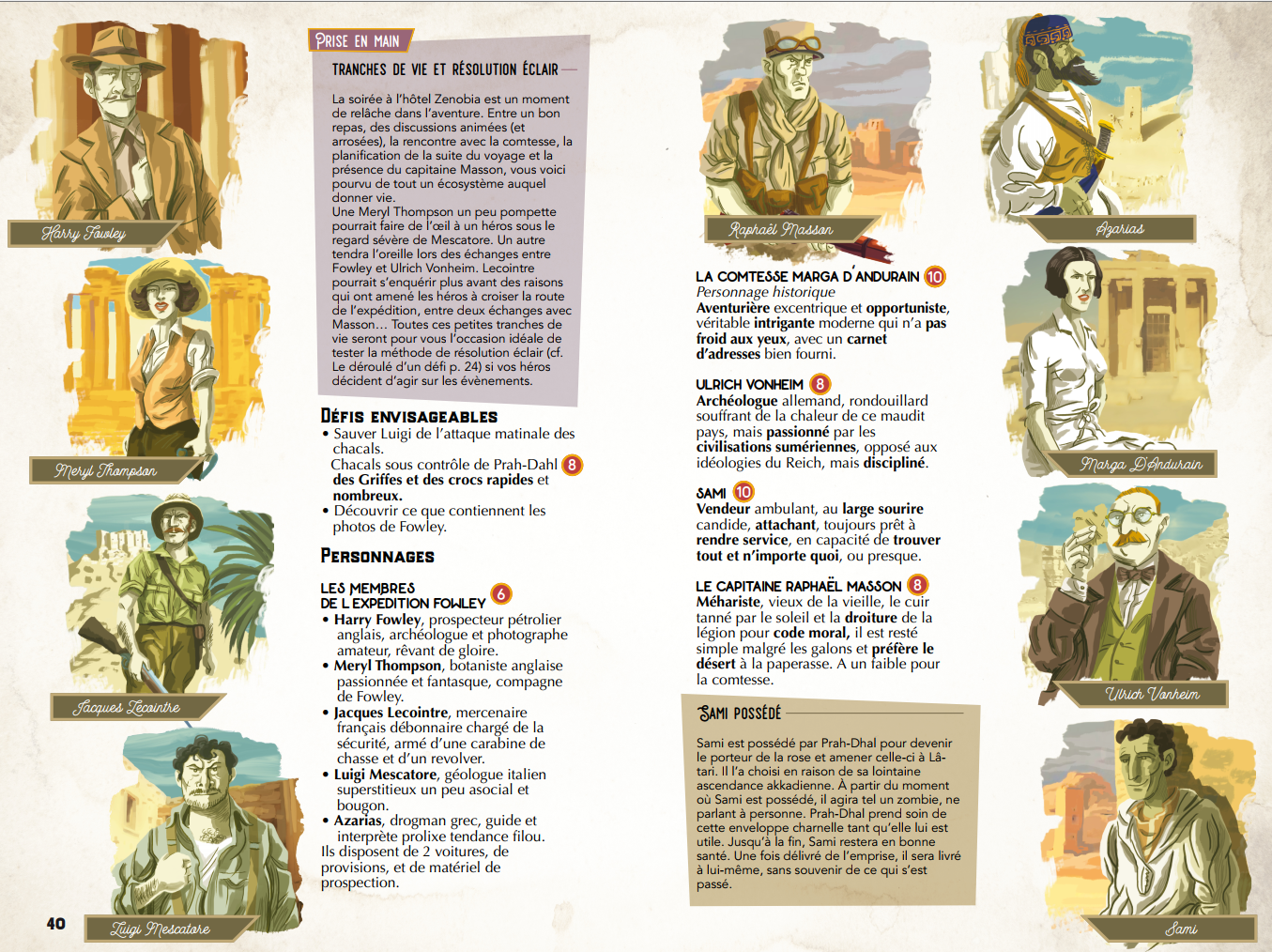 arkeos NPCs
arkeos NPCs
It even plays like a boardgame…
There are subtleties of course: characters can help each other, players can spend Plot tokens they’ve earned previously to affect the narrative, etc. If a character spends more than half their current tokens on a single action, they must draw a Fortune card (some have positive or negative modifiers, some add something to the fiction).
A rule I really like: as a player only wins if they beat the card they’re facing, they can risk everything in case of a tie. They flip a coin, either reducing the card to zero or losing all their Daring tokens and therefore failing at the whole Challenge.
Yet it’s a fiction first RPG!
Having not played the game (yet) I don’t know if it runs as smoothly as I think it does. But these mechanics look like they could bypass the conversation entirely:
GM: Out of the shadows comes out a burly figure you recognise. (Puts down a card worth 6). She plants herself in front of the door and declares in her thick German accent: “I have orders. The ritual must be conducted without interruption. But do try to get in, Ms Lundgren, so I can finally crack your Dummkopf open.” Player: I say: “It will be my pleasure to crack yours, Heidi dear,” as I take a sip of my hip flask… and suckerpunch her square in the jaw! (Advances 3 tokens and points to her Action of 2 and +2 for the Liquid Courage resource, on her character sheet.) GM: She goes off like a lamp. You walk over her and open the door…
With everything laid out on the table, stakes are obvious to everyone and tension can build up as players push their luck. With a little practice, it looks like a session could be almost completely devoid of gameplay conversation.
Build your PC with adjectives
As a fan of FKR games, I believe you can create a fun TTRPG character with a couple of sentences and not a single numbered value. Arkeos works in the same kind of way, even if it doesn’t eschew maths entirely.
Characters are defined by traits that give points adding up to three abilities: Action, Thinking, and Interaction — the pregens in the booklet have scores ranging from 0 to 6, and I don’t think the full character creation rules will let you go much higher, if at all. Like all good pulp action heroes, Arkeos characters also have weaknesses (claustrophobic, hopeless romantic…) and special gear that’s more like special abilities: a pocket bible that will absorb some some damage once, or good hiking shoes that lower risks in some precarious situations.
Taking the character sheet for ‘Cap’ Edward Nesbitt, I could sum up his stats as: a brainy mercenary and a learned fighter, who suffers from motion sickness, and has a pocket logic puzzle and a signature weapon, both with special effects. The pregen characters are rounded off with a presentation and a motivation, a short sentence each.
Given the fact that the traits are organised as archetypes, occupations, profile, and talents, it looks like character creation will be a breeze.
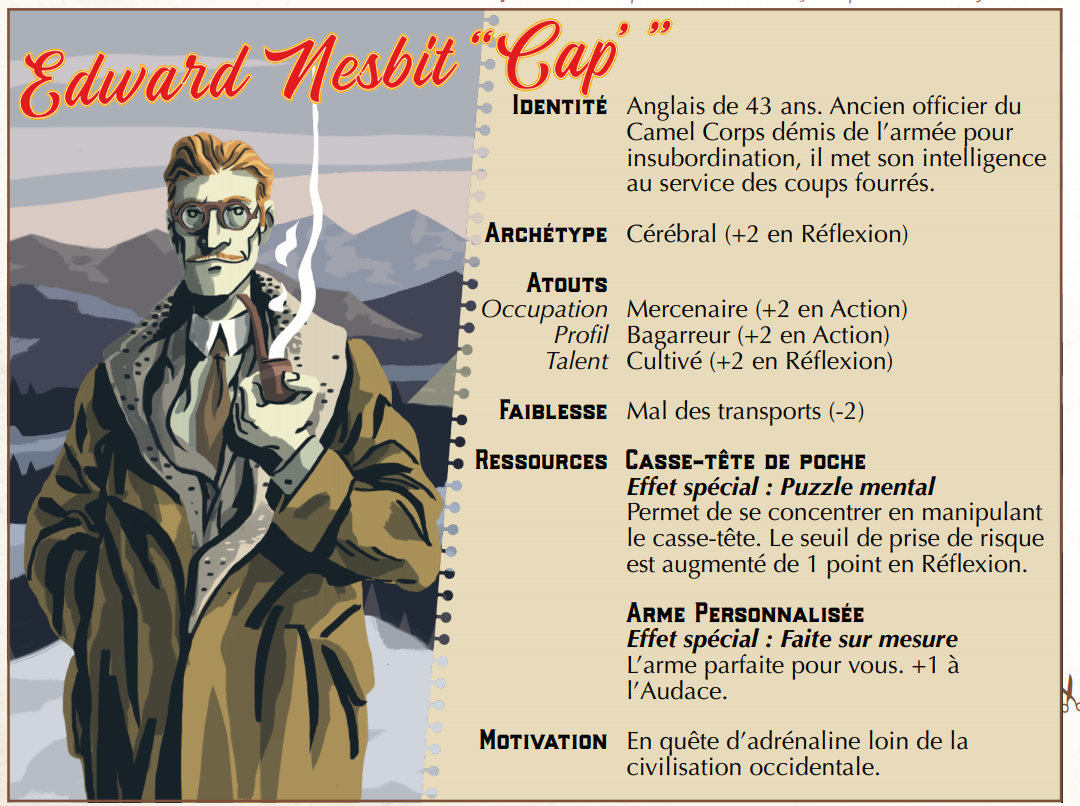 I’ve rambled enough, so I’ll just add that the booklet has a long adventure, complete with a lot of historical background and photos dripping with atmosphere.
I’ve rambled enough, so I’ll just add that the booklet has a long adventure, complete with a lot of historical background and photos dripping with atmosphere.
I’m excited about this game, even if I’m not sure I’ll ever get to run it (I’d have to track down enough French speaking gamers around me).
PlayLog: XCrawl Classics
Since its inception towards the end of the d20 bubble, Xcrawl has always been something I wanted to check out — televised dungeon crawling as the world’s most popular form of entertainment always stroke me as a genius idea — but never enough to get the book, I guess. Fortunately, the Kickstarter campaign for the DCC based new edition happened at a time when my gaming life wasn’t saturated in d20 fantasy games. So I took the plunge, and a few months later, I don’t regret it. XCC is everything I hoped: tons of DCC style fun art, whacky rules with enough deviation from the original to make it interesting, and a setting that’s just as fun as I was expecting. I didn’t go for the full package, but I bought the funnel module, which is what I ran for a small group of players with various TTRPG backgrounds. We played three sessions, and we had 14 deaths. Call me Killer Judge Eric now please. The group is still up for more, so I made sure I preordered the modules I’ll need to challenge Xcrawl’s newest Division III squad.
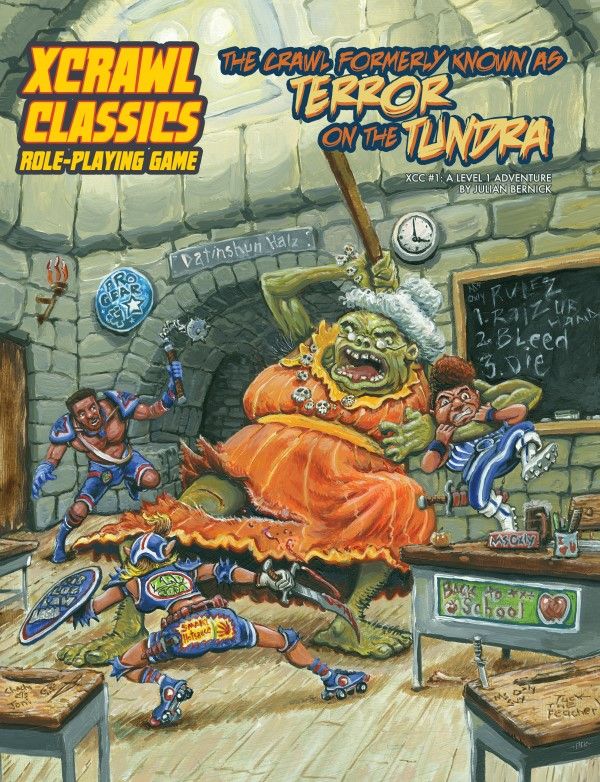 Gonzo turned up to 11
Gonzo turned up to 11
Not you daddy’s dungeon crawl
So, sore point perhaps: an Xcrawl is not an old-school dungeon. It is an arena built to entertain both the local crowd and people on TV. Crawlers don’t get to play factions against each other or look for a way around a monster. XCC crawls are more like funhouse dungeon with commentators. Of course, this doesn’t make the game less entertaining. After all, post 3E players expect their dungeons to work this way: puzzles, challenges, tactically interesting fights, and the occasional roleplay encounter. And it works even better with a shitload of tongues in cheek dropped into the formula. The crawls I’ve read so far crank the gonzo to d11. Typing this makes me wonder how one could add some of the features we adventure gamers like to say make a good dungeon. Giving choices to the contestants, or the option to ally with some of the enemies would make for good television. I don’t see why some Dungeon Judges wouldn’t try this to surprise their audience, as long as they get the blood they came for. And typing that, I wonder about adding some not so subtle subtext to the game with a new-old school of DJs building crawls based on the original gameplay of the Dungeonbattle RPG (because of course, Xcrawl is inspired by the tabletop RPG that took the Empire by storm in the 1970s). XCrawl Renaissance, anyone?
But there’s life outside the dungeons
But I hope to run some sessions outside of the crawls, so we can explore the world and have some variety. The short chapters on Xworld and the history of Xcrawl are a delight to read. The North American Empire is a points of light setting, with walled cities and most of its surface peopled by barbarians (human or otherwise) and ruled by dragons. Who knows what wonders exist in these untamed lands, and who could best explore them than professional dungeon crawlers? They may start complaining about having to carry their treasure instead of having it carted back to green room by the staff. The wilderness doesn’t hand out vouchers for Georgio’s Armour Emporium. Wealth is in the hands of the nobility, corruption and crime is everywhere, and justice is scarce. For a commoner, there aren’t many ways to ascend socially, or even make a comfortable living besides becoming modern day gladiators. Even organised crime is riddled with nepotism. The game alludes to urban adventures and it’s easy to come up with ideas to involve a team of career killers into shenanigans involving there agent, coach, or loved ones. How do you take out a gang boss when their hideout doesn’t follow guild fairness guidelines and their goons pack guns? I’m looking forward to giving some real, non televised trouble to my crawlers.
ReadLog: We Deal in Lead
Funny how games come in waves. I was reading Eco Mofos before going to LasagnaCon. At LasagnaCon I picked up the new Cairn Player’s Guide from Paolo. And not a week later, going to Wayland Games to get something else, I saw three By Odin’s Beard books on the new arrivals tables. Among which was We Deal in Lead. When I realised this is not just a weird west game, but a weird west game directly inspired by Stephen King’s Dark Tower novels, I just couldn’t put it back on the table. Sorry, Runecairn, you didn’t stand a chance.
 Art by Kim Diaz Holm
Art by Kim Diaz Holm
We Deal in Lead is a straight Cairn hack by Colin le Sueur. Play an Order of hardened gunslingers, armed with magical shootin’ irons, riding together on a quest among the ruins of a world that moved on. As every other game of its kin, you can hit the ground running: roll on the character creation tables, discuss a few details together, and you’re ready to ride the dusty trails of the Driftworld.
On top of the Into the Odd core rules (at the risk of repeating myself, still the most streamlined engine for efficient old schooling), it has rules for animal companions (aka non-human gunslingers), ritual magic, and of course magical boomsticks. I like the short and efficient hexcrawling procedure with default encounter tables by environment (windshorn mountains, bleached deserts, but also irradiated sprawls), and the excursion generator that’s part scenario ideas and part solo crawl rules (which are completed by another short chapter including a tarot inspired oracle. The bestiary has about 40 spooky critters from spideer to serfbot. And there are monster creation and conversion guidelines as well.
The book is sewn hardbound, 88 full colour pages on thick paper inside a gorgeous Goran Gligović cover. The art is maybe a bit inconsistent in style, but each piece is atmospheric and/or illustrative though, so no complaint from me. I would also have liked a more complex starting adventure, but in 5 pages, Swampwater Shootout has atmosphere in spades and can be used as a springboard for a longer saga.
The biggest selling point for We Deal in Lead as far as I’m concerned is the slipdoors. Like King’s series, We Deal in Lead proposes to send your gun-toting knights questing into strange places. Places like, I don’t know, [the Vald](https://cairnrpg.com/, or Bastion, or fantasy Sumer, or another post-apocalyptic world or three. I’m also wondering if I could use more than just the setting from Mythic Bastionland… What I know for sure is I’d defo mine Frontier Scum for bleak western material (and probably the saved-by-your-hat rule).
You can get the PDF of We Deal in Lead on itch and the book directly from Odin’s Beard. I’ll add that the game has possibly the best official RPG soundtrack I’ve ever heard (which you can stream on Of Sleeping Bears’ bandcamp).
ReadLog: Eco Mofos
I’ve been leafing through the adventure mini-modules that came with Eco Mofos and I’m happy to report my initial impression is 100% confirmed: this game fucking slays!
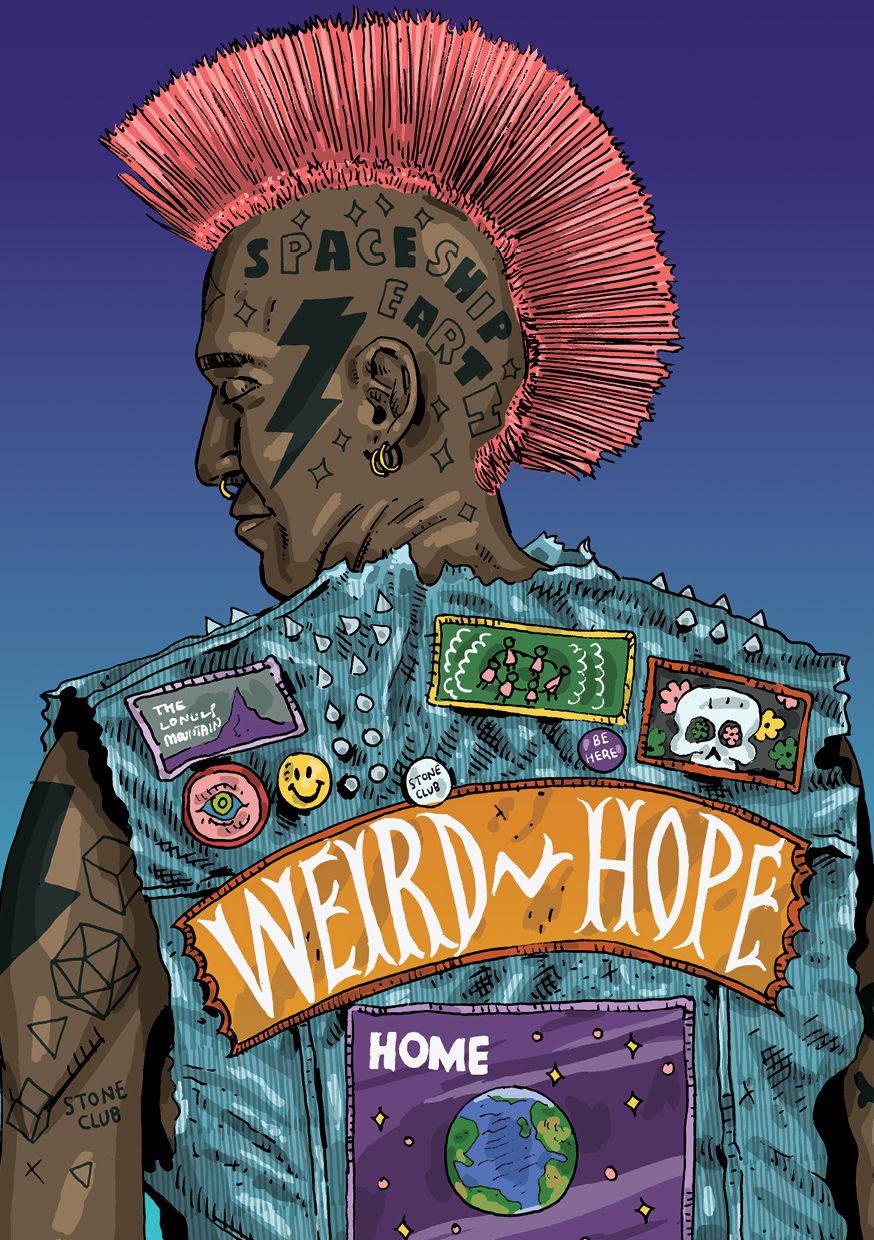 Eco Mofos
Eco Mofos
A ‘weirdhope’ post-apocalypse setting with tons of weird stuff to see and do and build upon. Yes, the world is broken, but we can try to fix it. It’s a Mark of the Odd game, aka the ultimate distillation of old school mechanics, tense and barely noticed in play. Your character starts with a basic concept like Freak or Fighter but soon becomes unique as they collect weird items and strange powers.
It also means EM is compatible with a galaxy of games you can borrow from. Mail Order Apocalypse fits the bill perfectly, or Monolith for harder SF, or questing multiversal cowboys from We Deal in Lead (more on these later), and why not throw a spooky cursed forest in there with a couple of Cairn adventures?
But even without any of these ‘lateral supplements’, it’s more than enough to start your group of punks on their quest for the peaceful, safe Glade where they can build a new home.
My only minor gripe is, despite how beautiful and streamlined the book is, a couple of rules took me a minute to grok. (But it was the same with Into the Odd back in the day, so maybe my brain isn’t great with pared down mechanical elegance :)
The PDF of Eco Mofos is a fiver on David’s itch page, so why don’t you just?
(adapted from a Mastodon post)
An attempt at regular web logging
Because I don’t want to waste a specialty coffee’s worth in Blot subscription, I have decided to post some low friction things. It was the point of having a low friction blog in the first place. I will then try to log some of the things I read, watch, and play on a regular basis.
Think of this as the semi-elaborate review or impression social media posts I don’t do anymore because fuck Musk and yuck Zuck. I mean, I’m on Mastodon but my account is set to delete on a regular basis so I might also paste some of my posts there.
So, yeah. Don’t hold your breath for more than “Hey you should watch this!” and “Does anyone know about that?” posts around here. At least not until I’ve got back into the swing of web logging things again.
ConLog LasagnaCon 7
Friday
I flew to Glasgow from Dublin Friday afternoon and landed just in time to meet Paolo, Gustav, Roger, and game jam organiser Gabe at the BECO building (aka Barclay’s Eagle Labs coworking space). The space is just as nice as you’d expect a bank owned startup incubator. Three floors with big desks we could commandeer for board games, meeting rooms for RPGs, kitchens, the works.
That evening, we had just a couple hours after the customary chats and lasagne to play, so Paolo ran a pick up session of Dwarf Land. We rolled silly characters and were sent on a mission, which we chose to mostly ignore so we could hire some rabbits to build a reverse pyramid for us.
Saturday
Most of the day was taken by Roger’s exploration of Slave Pits of the Undercity using his own 52 Pages ruleset (it is indeed 52 pages long, but it’s also called 52 Pages). We had were six to eight players at any time, with eight 5th level characters and a few followers in tow. It was an interesting experience, I think especially for a ‘young’ grognard like me: when you have a dozen delvers, stealth mode becomes very challenging: light sources, noise management, and the sheer space taken by such a large group makes avoiding notice and pursuit interesting. And if the gnome at the back of the column decides to go and explore by themselves, there isn’t much the more tactically minded characters at the front can do. We didn’t make it into the titular slave pits, but got in a few scrapes where the rules showed their potential. 52 Pages strides the line between simplicity and heroism with ease. (I’m not including a link as the last publicly shared version seems to be from 2016. Roger has done quite a bit of work on it since then.)
Later, Roz, Richard and myself tried playing Vial Belli with three players but, as I’ve confirmed by watching the rules video on the itch page linked here, we didn’t have all the rules right. There wasn’t much time to try a two- or four-player game, so I’ll have to update later with full thoughts on this cool little card war game. We followed this with a couple rounds of Scout, which is an easy to learn and fun card game with a thin theme of circus management. I’d never seen the hand management mechanic before.
Sunday
The main event was Paolo’s playtest of Sorcerers & Shenanigans. Based on Gangs & Bullshit but whackier, this is a game of apprentice sorcerers going wild while their master is away. Exploring the tower and the region surrounding it, getting in all sorts of trouble, and generally not caring much about the various crises threatening the land. The game was a blast. It has very simple mechanics and a unique turn structure, which lets a GM work with a large number of players. We played for four to five hours with eight characters and so much shenanigans happened over the course of nine months of game time. It was interesting to see how some apprentices became accomplished wizards, while others didn’t but made friends and arguably accomplished more in the world. Props to Chris for mutating into a Chaos Cat and prompting their new ice dragon god master to take over a city.
During a break, Chris led four of us in a short session of a GMless game he’d acquired that same morning: Stack of Goblins. Nothing new theme wise: you play goblins piled in a trenchcoat sent on a randomly generated mission. I liked that narrative power is distributed according to your goblin’s place in the stack.
And then it was time for Christine’s now traditional session of Mörk Borg. I had kept last year’s character and brother Björnus wasn’t as lucky and finally succumbed to a Type III CyberDemon’s blaster gun. The adventure was supported by Christine’s really cool map and art.
Sunday was arguably better attended. There were people playing board games, and a multi-setting session of 24XX was held in one of the side booths. I wish I could have played in that too but in any case it was great to see this game in the wild!
Monday
There was just enough time to have coffee and say goodbye and thank you to Paolo. Turned out Roger and I were on the same southbound train, so we chatted about 52 Pages for a good bit, long enough to convince me to try running it. These pages are just filled to the brim with simple and clever procedures for old school adventure gaming.
After he jumped off to make his connection, I spent the rest of the trip doing some edits on adventures for Dungeon, Inc., and listened to episode 14 of When We Were Wizards. Wonder if it’s the last one or if they’re planning a more upbeat summary of the series…
I’m probably forgetting things. I have zero brain today and the coffee isn’t helping.